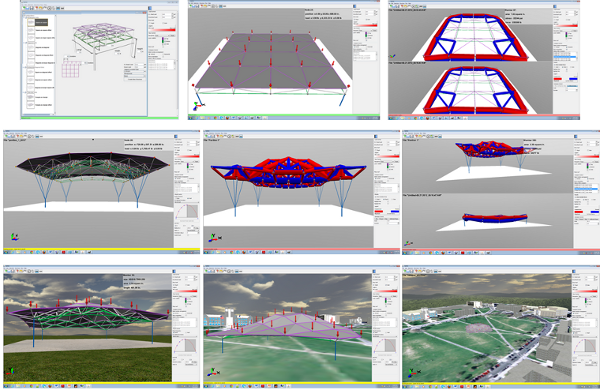|
<<Back to Home
SAFAS is an Extensible 3D (X3D) web-enabled
application built using open standards and open-source tools such as Xj3D,
Java Swing
and Apache. We continue to
develop features and knowledgebase integration with the SAFAS tool.
We are evaluating and improving the tool through class usage in
Junior year architecture studio and lecture classes at Virginia Tech
and with our partner universities.
RESOURCES (updated May 30, 2014):
-
Download alpha SAFAS client application
software (version 1.7) for your platform below:
-
Windows
Installer - ! New ! this will check your version of Java, and download one as needed; A SAFAS shortcut will also be added to your Start Menu and Desktop
If you are using Windows-based computers, you should load the SAFAS Installer!
IMPORTANT NOTE: Before running SAFAS, please make sure to update the graphics driver for your computer video card!
- Java Jars (zipped)
-
Mac OS X (Intel)
Java Jar (zipped)
-
Linux i586
Java Jar (zipped)
-
Linux amd64
Java Jar (zipped)
IMPORTANT
- Make sure you have the latest graphics driver for your video card
- Make sure you have the latest version of java installed in your
machine.
- To run the SAFAS , click on the shortcut on your desktop (if you have used the installer) or just open the file named 'safas.jar'
- If you have any issues or you do not know how to perform any of these steps, go to the FAQ page. If you cannot fix the issue or if your issue is not listed there, please email safasinfo@listserv.vt.edu
-
Free, but required for using the SAFAS-SAP server.
Send an email to: safasinfo @ listserv.vt.edu with the Subject 'SAFAS Account Request';
please include your name, affiliation, email and purpose in the request email!
-
-
Features
We continue to evaluate, refine and improve the SAFAS codebase and functionality.
The current build provides :
- Specification and construction of a spatial structure
(l, w,
h) based on one of 11 repeating units
- Addition of column elements
- Show/Hide solid decking on top, bottom layers
- Direct-manipulation deformation of the spatial
structure
- parameterized Sphere and Cylinder deformers
- graphical response-curve editor
- can effect top, bottom layer or both
- Computation of initial loading
- Save structure to SAP-4 / SAP-2000 input format
- Load structural simulation results from SAP file
(load, tension, compression; initial mapping shows simulation result
values as color-per-node, color-per-member and displacement)
Publications
Setareh, M., Bacim, F., Jones, B.D., Polys, N. F., Geng, T., Orsa, B. “Integrating Web-based Visualization with Structural System Understanding to Improve the Technical Education of Architects.” Journal of Online Engineering Education 3(2).
Nicholas F. Polys, Felipe Bacim, Mehdi Setareh, and Brett Jones. 2013. “Building novel Web3D user interfaces: a case study from architecture and structural engineering”. In Proceedings of the 18th International Conference on 3D Web Technology (Web3D '13). ACM, San Sebastian ES, 135-138.
F. Bacim, E. Ragan, S. Serbo, M. Setareh, B. D. Jones, N. Polys. “The Effects of Display Fidelity, Visual Complexity, and Task Scope on Spatial Understanding of 3D Graphs.” Proceedings of Graphics Interface, Regina, 2013. ISBN: 9781482216806
M. Setareh, F. Bacim, B. D. Jones, N. F. Polys, T. Geng, B. Orsa. “Integrating Web-based Visualization with Structural System Understanding to Improve the Technical Education of Architects.” Journal of Online Engineering Education 3(2).
Bacim, F., Polys, N., Chen, J., Setareh, M., Li, J., and Ma, L. “Cognitive scaffolding in Web3D learning systems: a case study for form and structure”. In Proceedings of the 15th international Conference on Web 3D Technology (Los Angeles, California, July 24 – 25, 2010). Web3D ’10. ACM, 2010.
Software Architecture
We built the client design software to with a Model-View-Controller (MVC)
architecture, which enables a clean separation of concerns between user
interface and the system / data model. Currently, the SAFAS application is
deployed as a cross-platform Java Jar with both 32 and 64 bit support.

The software architecture of the client tool.
<<Back to Home
|

